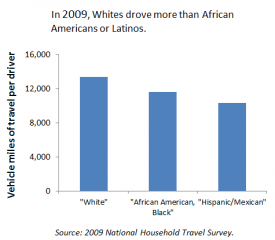The US is smack in the middle of two major demographic shifts: it’s aging, and at the same time it’s getting more racially and ethnically diverse. We’ve already discussed the effects of aging on driving: as the baby boomers move towards retirement they’ll drive less, and we can expect per capita vehicle travel to fall as a result.
But how will diversity trends—particularly the increasing numbers of Latinos in the US—affect the nation’s driving patterns in years to come? This study, by researchers from the Southern California Association of Governments,  argues that increasing diversity will alter driving habits every bit as profoundly as will generational shifts. And the 2009 National Household Travel Survey offers some support for that claim, since it shows that African Americans and Latinos drive much less than do non-Hispanic whites. (Click on the chart for a more legible version.)
argues that increasing diversity will alter driving habits every bit as profoundly as will generational shifts. And the 2009 National Household Travel Survey offers some support for that claim, since it shows that African Americans and Latinos drive much less than do non-Hispanic whites. (Click on the chart for a more legible version.)
But I’m not sure I buy it—not completely, at least. As far as I can tell, the California researchers looked narrowly at race and ethnicity, without factoring in the effects of income or neighborhoods on driving habits. But diving into the numbers a bit, it looks to me as if income inequality, rather than diversity, is the real trend to watch.
The NHTS allows you to compare people in similar circumstances—say, folks with the same household income, or who live in neighborhoods with similar densities. And when I do that, the vehicle travel differences among races and ethnicities mostly melt away: middle-income African Americans who live in a medium-density neighborhood, for example, drive almost exactly the same amount as similarly situated whites.
Looking across the full range of incomes and neighborhood densities, Latinos and African Americans wind up driving just a tad less than non-Hispanic whites. But what really affects driving is where you live and how much you earn, not your heritage or the color of your skin.
Of course, I’d need to do a much more sophisticated analysis to fully untangle the effects of income, neighborhood, and other demographic factors on driving. That’s somewhat tricky, because the NHTS is known to under-sample low-income households, and its information on lower-income minority populations is particularly spotty. But in my brief look at the numbers, the effects of income and neighborhoods (controlling for race and ethnicity) seemed profound; but the effects of race and ethnicity (controlling for income and neighborhoods) seemed minor.
But that points to a major question for the future. Right now, Latinos tend to drive less than non-Hispanic whites mostly because Latinos earn less. And if these income differences persist, the growth of the nation’s Latino population really could have a profound impact on driving patterns—not for any cultural reasons, but simply because folks who are struggling economically simply can’t afford to spend as much on cars and gas.
But that’s not just true for Latinos—it’s true for everyone. If lower-income families lose ground, and if the earning power of the middle class stagnates or declines, then economic trends will put downward pressure on driving. Conversely, if economic trends reverse, and lower-income folks find greater success in increasing their after-tax incomes, we could find that driving rates get a boost.
Either way, the real trends to watch are related to income inequality, not changes in the racial or ethnic makeup of the country.








Alex
What about the age differences by race/ethnicity? The age distribution for Latinos skews younger. If younger people drive less, that should also make Latinos as a whole drive less than the rest of the population.
Clark Williams-Derry
Great point!
I’d have to do a bunch of fancy model-building from the original data to untangle age vs. income vs. neighborhood vs. other factors. But I suspect you’re exactly right: based on other things we know, a population that skews young will also probably drive a little less than a population that’s got more folks in the 35-50 range. That said, a population with fewer seniors might have higher per capita driving, since seniors drive very little.
Either way, it’s a good point — but one that I’d probably have to untangle with actual math.
Sam
Makes sense to me…people in higher paying knowledge working jobs may be more likely to drive due to the particular nature and scarcity. People in low-income jobs can generally work anywhere.
Also, if you have more money, you’re likely to pay for things like parking and what not (instead of taking cheaper public transportation as much).